|
|
|
 |
Parallel Port Programmer |
|
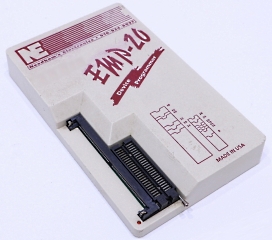
The Needham EMP-20 Parallel Port Programmer
Although the TOP853
programmer includes the TI 2564 (8k EPROM) in its list of
supported devices, I found that my TOP853 could neither read nor
write a 2564. After searching the web for other programmers that
were supposed to support the 2564, I was considering upgrading
to a later model TOP programmer; both the TOP3000 and TOP3100
included the 2564 in their lists of supported devices, but,
given my experience with the TOP853, I was somewhat wary of
spending over £100 on something that might also fail to work as
advertised.
Instead, I managed to find a Needham EMP-20 on
eBay. Having used one of these programmers some 20 years ago, I
was confident that it would do the job. The obvious drawback
with the device is that it uses a parallel port connection to
the PC. Most of my PCs do not have a parallel port, but I do
have a Thinkpad laptop with a parallel port in its port
replicator.
The other potential issue with the EMP-20 is
that the software runs under DOS only and will not run in a DOS
box under the most recent versions of Windows (after Windows 7).
Windows 3.1, 95 and 98 should be OK, computers running Windows
XP have variable results. There is a Driver Update that should
allow the programmer to work under Windows XP (or NT/2000).
My EMP-20 was missing its power supply, the Needham
pages on archive.org advised that the power supply was 12-16 Volts @
2.5 Amp, AC or DC
"The EMP-20 programmer is an inexpensive, portable,
parallel port programmer that was designed from the ground up to be
fast and versatile. It easily connects to your PC through a standard
parallel port." The EMP-20 uses plug-in "family modules" to
configure the programmer for different devices." Each family module
supports an entire family of devices. Three family modules are
included in the base price of the programmer to support 8/16 bit
EPROMS, 87xxx MICROS, and a number of PLDs.

Family Modules are not an entirely new idea. They
have been use in other programmers from time to time, to
inexpensively route power and ground to the device. When you're
programming devices fairly slow, then straight, slide-in connectors
are just fine. However, the EMP-20 programs at speeds near the
theoretical maximum of some devices, so the digital signals
traveling to the device must be clean, and the power and ground
lines must be solid. Slide-in connectors can experience noise
problems, higher resistance, and corrosion.
The following has been tested on a ThinkPad T61 with
a Type 2504 docking station/port replicator running Windows XP SP3.
The docking station that I originally used with my T61 was a
pretty simple port replicator - it did not have a parallel
port.
When I bought the EMP-20, I ordered a more
advanced version of the docking station from a computer
recycler on eBay. Since the T61 is now well past its
"sell-by-date", I managed to get a Type 2504 for £7.50
including P&P. |
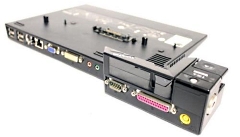 |
Driver Installation
Unzip EMPNT.ZIP
(available at the bottom of the page) which will create
EMPNT.EXE.
Run the program with Administrator
permissions.
Select the EMP-20 programmer and the
Port Base for the parallel port.
The default PC
parallel port is 0x3BC, this can be checked from the
parallel port properties in Device Manager. |
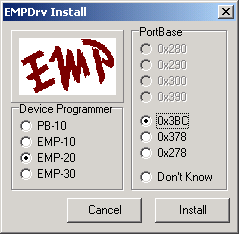 |
Windows NT (and Windows XP) do not allow direct access to
the parallel port from a Window.
The driver
installation displays the information box opposite which
describes how the run the EMP-20 programmer software in Full
Screen mode. |
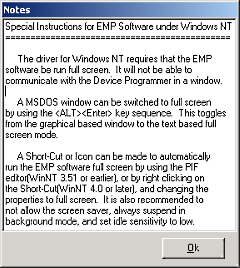 |
|
Once the driver installation has completed, the computer
needs to be rebooted. |
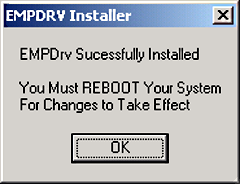 |
When the EMP20 program is run, a
Splash screen is displayed which confirms the version
number. The latest version that I have found is Version
4.18.
NB
: For presentation reasons, most of the screen captures on
this page were done in Window mode - the program needs to be
run Full Screen in order to access the parallel port. |
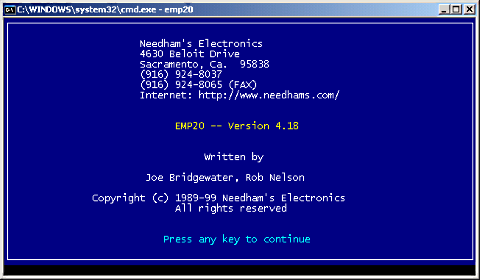 |
| If the driver has not been
installed correctly, the program is running in a window,
rather than full screen or the parallel port is otherwise
unavailable, the program displays this error message. |
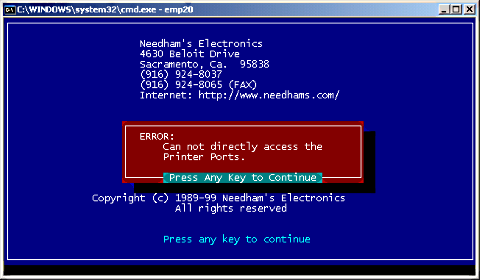 |
If the parallel port is accessible,
but the programmer cannot be found, the program displays
this error message.
|
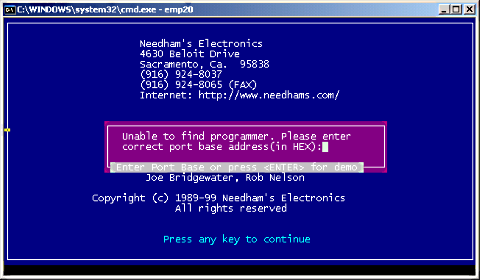 |
| If the programmer cannot be found,
the program can be run in "Demo" mode. |
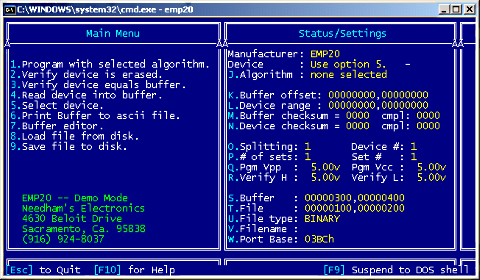 |
| |
|
| |
|
| |
|
| |
|
| |
|
| |
|
| |
|
When the programmer is plugged in, the Device Driver
will be loaded and the system should be ready to go.
|
|
 |
|